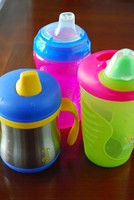 You’d think that humans would be smart enough to stop poisoning ourselves—or at least our babies. But, no.
You’d think that humans would be smart enough to stop poisoning ourselves—or at least our babies. But, no.
Turns out that all the BPA-free products—the ones I’ve sought out to protect my dear little girl’s reproductive system and to ward off cancer and neurological problems—may have given me a false sense of security.
The power of concerned parents to get manufacturers—and sometimes governments (Maine just approved a ban on BPA in reusable food and beverage containers that will go into effect next year; Oregon is considering banning it in sippy cups and baby bottles)—to remove certain toxics from kids’ products can be a double-edged sword. The problem is that when we all got on the BPA-free bandwagon, BPA began to be replaced by other toxics—some of them known to be linked to health hazards and others totally unknown and untested!
Basically, we’re swapping one endocrine-system disrupting, cancer causing bisphenol for another. Dominique Browning, a blogger at Moms CleanAirForce and author of “Slow Love: How I Lost My Job, Put on My Pajamas and Found Happiness,” wrote about it in a New York Times op-ed this week:
Bisphenols are shaping up to be a dysfunctional family of chemicals. BPAF is BPA’s fluorinated twin. It is used in electronic devices, optical fibers and more. New studies have found BPAF to be an even more potent endocrine disrupter than BPA. Bisphenol B and Bisphenol F are other variants used instead of BPA in various products. In the limited testing done on those chemicals in other countries, scientists found Bisphenol B to be more potent than BPA in stimulating breast cancer cells.
A similar drama played out with PBDEs, a family of flame-retarding chemicals that have been linked to serious health problems, such as altered hormone levels, abnormal brain development and fertility issues. PBDEs migrate off electronic casings or are released from foam cushions. (It is no small irony that we worry about what our kids are watching on their computers instead of the toxic stuff coming off some of their equipment.) Under intense pressure, manufacturers have begun to replace PBDEs—with new, untested chemicals whose effect on people is unknown.
(Emphasis mine.)
As Browning puts it, this kind of swapping is an illustration of a broken system for consumer protection.
The problem is that our regulatory system allows manufacturers to introduce or continue to use chemicals that have not been adequately tested for safety. A manufacturer can replace BPA with another untested compound and get a few years’ use out of it before it, too, becomes the subject of health alerts or news media attention. By the time we know what those new chemicals do to us, entire generations are affected.
It makes far more sense to test first—well before our kids become guinea pigs. It seems like a no-brainer that manufacturers should only be able to sell us stuff that isn’t going to give us cancer or other chronic illnesses. And, maybe it’s not just product manufacturers who can do better. Evan Beach at Environmental Health News points out that chemical producers could do more upstream testing as well—from teaching chemists the basics about toxic phenomena, to industry toxicity tests, ranging from computer models to animal studies, and setting better molecular design guidelines before chemicals even leave the lab.
So, what can bewildered and busy parents do before our heads explode? For one, cut out plastics as much as possible. Go for glass baby bottles. I’m going to look into metal sippy cups I’ve seen around. And…It’s time to learn to deal with spilled milk when you try to get your 1.5 year old to drink from a regular old drinking glass!
We can also demand action from lawmakers.
Senator Frank R. Lautenberg of New Jersey, bless his heart, recently introduced a bill to change the United States’ main chemical safety law, the Toxic Substances Control Act, so that chemical companies would have to demonstrate that products are safe before they are sold to consumers—the way we regulate food additives and medicine.
As Browning says, we should make as much noise as “fussy newborns”—with the fierce passion only a parent’s love can generate—to get Congress to pay attention to Senator Lautenberg’s proposal and, more broadly, to chemical regulation that makes sense for families and not just manufacturers’ bottom lines.
Image courtesy Slice of Chic, Flickr.com, under a Creative Commons license.

Comments are closed.